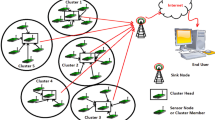Abstract
Energy efficiency in wireless sensor networks (WSNs) is one of the most important factors influencing the networks’ performance. Energy efficiency is recognized as a critical problem in WSNs so it is important to minimize the total energy consumed by the nodes in a round. Many routing protocols have been proposed to extend networks lifetime through finding energy efficient routing paths. In his paper, we propose a multi-hop routing energy efficient scheme that considers residual energy and distance factors to develop optimal clusters and cluster heads for achieving efficiency and prolonging network lifetime. By MRRCE, rounds in which the first node dies and the last node dies are greatly increased. Moreover, the simulation results prove low energy consumption and lifetime increase. As another contribution of the paper, some algorithms like Low Energy Adaptive Clustering Hierarchy, Hybrid Energy Efficient Distributed (HEED), Extended HEED, DIRECT, Two-Dimensional Technique Based on Center of Gravity and Energy Center, Energy-Aware Evolutionary Routing Protocol and Energy-Efficient Unequal Clustering Mechanism have been analyzed.









Similar content being viewed by others
References
Bhattacharjee, S., & Bandyopadhyay, S. (2013). Lifetime maximizing dynamic energy efficient routing protocol for multi hop wireless networks. Simulation Modeling Practice and Theory, 32, 15–29.
Faisal, S., Javaid, N., Javaid, A., Khan, M. A., Bouk, S. H., & Khan, Z. A. (2013). Z-SEP: Zonal-stable election protocol for wireless sensor networks. Journal of Basic and Applied Scientific Research (JBASR), 3(5), 132–139.
Rezaei, E., & Baradaran, A. A. (2013). TDTCGE: Two-dimensional technique based on center of gravity and energy center in wireless sensor network. Journal of Basic and Applied Scientific Research (JBASR), 3(8), 194–201.
Liu, A., Ren, J., Li, X., Chen, Z. & Shen, X. (2012). Design principles and improvement of cost function based energy aware routing algorithms for wireless sensor networks. Computer Networks, 56(7), 1951–1967.
Sutar, U. & S. Bodhe (2010). Energy efficient topology control algorithm for multi Hop ad-hoc wireless sensor network. In Computer science and Information Technology (ICCSIT), 3rd IEEE international conference (pp. 418–421).
Zhenhua, W., Xiaodong, H., Hong, Z., & Chang’an, L. (2007). Research on clustering strategy for wireless sensor network based on fuzzy theory. In Conference on bio-inspired computing: Theories and applications (BIC-TA) (pp. 596–604).
Youssef, M., Youssef, A., & Younis, M. (2009) Overlapping multi-hop clustering for wireless sensor networks. In IEEE TPDS.
Senouci, M. R., Mellouk, A., Senouci, H., & Aissani, A. (2012). Performance evaluation of network lifetime spatial-temporal distribution for WSN routing protocols. Journal of Network and Computer Applications, 35(4), 1317–1328.
Liu, T., Li, Q., & Liang, P. (2012). An energy-balancing clustering approach for gradient-based routing in wireless sensor networks. Computer Communications, 35(17), 2150–2161.
Heinzelman, W., Chandrakasan, A. & Balakrishnan, H. (2000). Energy-efficient communication protocol for wireless micro sensor networks. In Proceedings of the 33rd international conference on system science (HICSS’00) (pp. 1–10). Hawaii, USA.
Butt, I. M. & Khan, S. A. (2005). Analyzing and enhancing energy efficient communication protocol for wireless micro-sensor networks. In ICICT, August 27–28 (pp. 323–327). Karachi, Pakistan.
Younis, O., & Fahmy, S. (2004). HEED: A hybrid, energy-efficient, distributed clustering approach for ad-hoc sensor networks. IEEE Transactions on MC, 3(4), 366–379.
Senouci, M. R., Mellouk, A., Senouci, H., & Aissani, A. (2012). Performance evaluation of network lifetime spatial-temporal distribution for WSN routing protocols. Journal of Network and Computer Applications, 35, 1317–1328.
Murray, M. P., Seireg, A., & Scholz, R. C. (1967). Center of gravity, center of pressure, and supportive forces during human activities. Journal of Applied Physiology, 23, 831–838.
Acton, M., Center of mass. In Physics LAB Copyright © 1997–2011 Catharine H. Colwell All rights reserved. Application programmer.
Khalil, E. A., & Attea, B. A. (2011). Energy-aware evolutionary routine protocol for dynamic clustering of wireless sensor networks. Swarm and Evolutionary Computation, 1(4), 195–203.
Li, C. F., Ye, M., Chen, G. H., & Wu, J. (2005). An energy-efficient unequal clustering mechanism for wireless sensor networks. In Proceedings of the IEEE international conference on mobile adhoc and sensor systems conference (pp. 1–8).
Visalakshi, N. K., & Thangavel, K. (2009). Impact of normalization in distributed K-means clustering. International Journal of Soft Computing, 4(4), 168–172.
Du, D.-Z., Smith, J. M., & Rubinstein, J. H. (2000). Advances in Steiner trees (pp. 163–174). Dordrecht: Kluwer.
Yildiz, M. C., & Madden, P. H. (2002). Preferred direction Steiner trees computer-aided design of integrated circuits and systems. IEEE Transactions, 21(11), 1368–1372.
Zhou, H. (2004). Efficient Steiner tree construction based on spanning graphs. IEEE Transactions on Computer-Aided Design of Integrated Circuits Systems, 23(5), 704–710.
Author information
Authors and Affiliations
Corresponding author
Rights and permissions
About this article
Cite this article
Rezaei, E., Baradaran, A.A. & Heydariyan, A. Multi-hop Routing Algorithm Using Steiner Points for Reducing Energy Consumption in Wireless Sensor Networks. Wireless Pers Commun 86, 1557–1570 (2016). https://doi.org/10.1007/s11277-015-3006-x
Published:
Issue Date:
DOI: https://doi.org/10.1007/s11277-015-3006-x




